
by Sheila Dunning | Jun 13, 2024
You may recognize the arrival of summer because of the intense buzzing sound coming from the trees. It can last all day long, with changes in the pitch and pattern of the screaming.
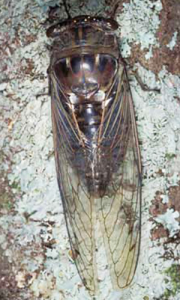
Dusk-calling cicada, Tibicen auletes (Germar). Total length (head to tips of forewings) is 64 mm (about 2 1/2 inches). Photograph by Lyle J. Buss, University of Florida.
Cicadas are large (3/4” – 2 ½”) winged insects with stocky bodies and bulging eyes. They spend the vast majority of their lives underground, emerging in massive numbers for just a few weeks to mate and lay eggs. This behavior often earns them the name “locusts,” which entomologically they are not.
In much of the eastern United States, periodical cicada (Magicicada spp.) broods rise up out of the ground every 13 or 17 years. In the summer of 2024, two different broods (one group of 13-year cicadas and one group of 17-year cicadas) will arrive at the same time across 16 states. The closest to us will be mid-lower Alabama. Approximately one trillion insects are anticipated. This only happens once every 221 years.
By emerging in large numbers, the cicadas are able to reduce the potential of being eaten by predators. Though many will be lost to birds and killer wasps, enough will survive to be able to reproduce.
Unlike the broods of periodical cicadas, populations of Florida’s 19 cicada species produce adults every year. However, the nymphs still spend several years developing underground. The nymphs use their piercing-sucking mouthparts to feed on the xylem sap in the roots of trees. The feeding can weaken already stressed trees. Most trees tolerate the damage quite well. After gaining enough nutrients, the nymphs wait for the soil to warm enough (approximately 64° F. at six inches deep) before crawling out of the ground, climbing up the tree trunk, and molting into adults with wings. You can often find the empty shed exoskeleton still hanging on the tree trunk.
The adult male spends all day being as loud as possible in order to attract the girls. Each species has its own song. Large numbers of insects create more noise. Male cicadas have a pair of tymbals located on the sides of their abdomen. Tymbals are corrugated regions of the cicada’s exoskeleton that can be vibrated so rapidly that the clicking sound becomes a high-pitched buzz. Cicadas with the best abs get the girls and reminds all the humans that summer is here.
To learn more about cicadas and train your ears to the different species call go to: https://entnemdept.ufl.edu/creatures/misc/bugs/cicadas.htm
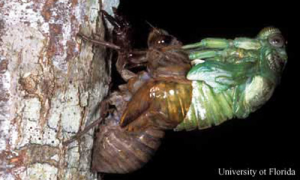
Cicada (Tibicen sp.) escaping its nymphal skeleton. The cast skeleton will remain attached to the tree. Once free, the adult will expand its wings, darken, and fly away. Photograph by Lyle J. Buss, University of Florida.
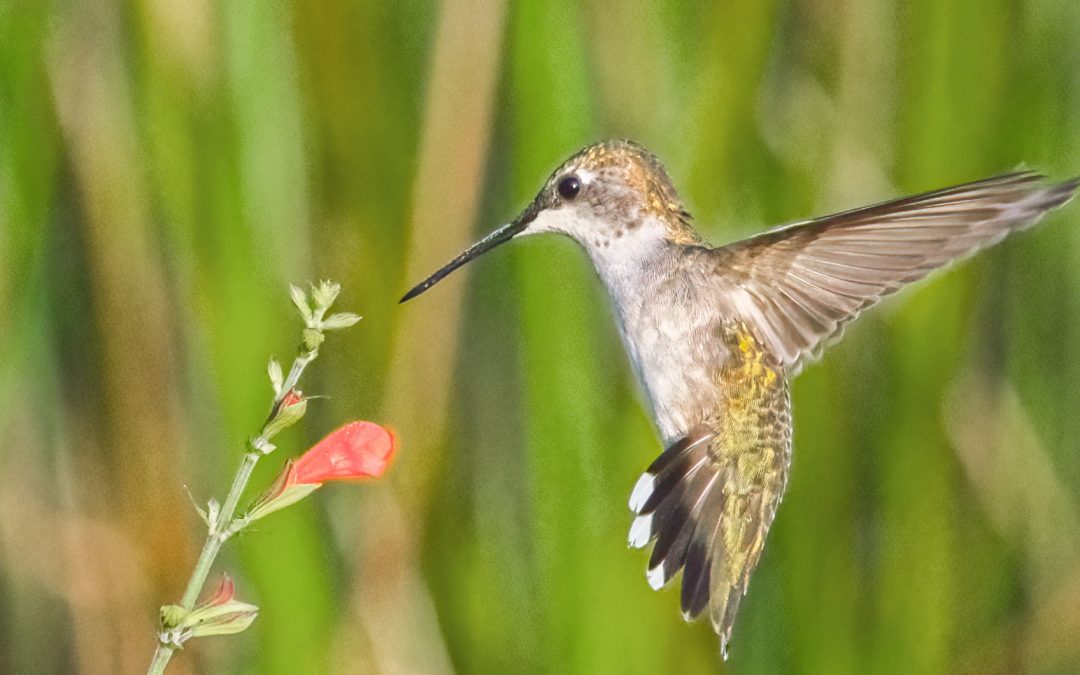
by Molly Jameson | Jun 5, 2024
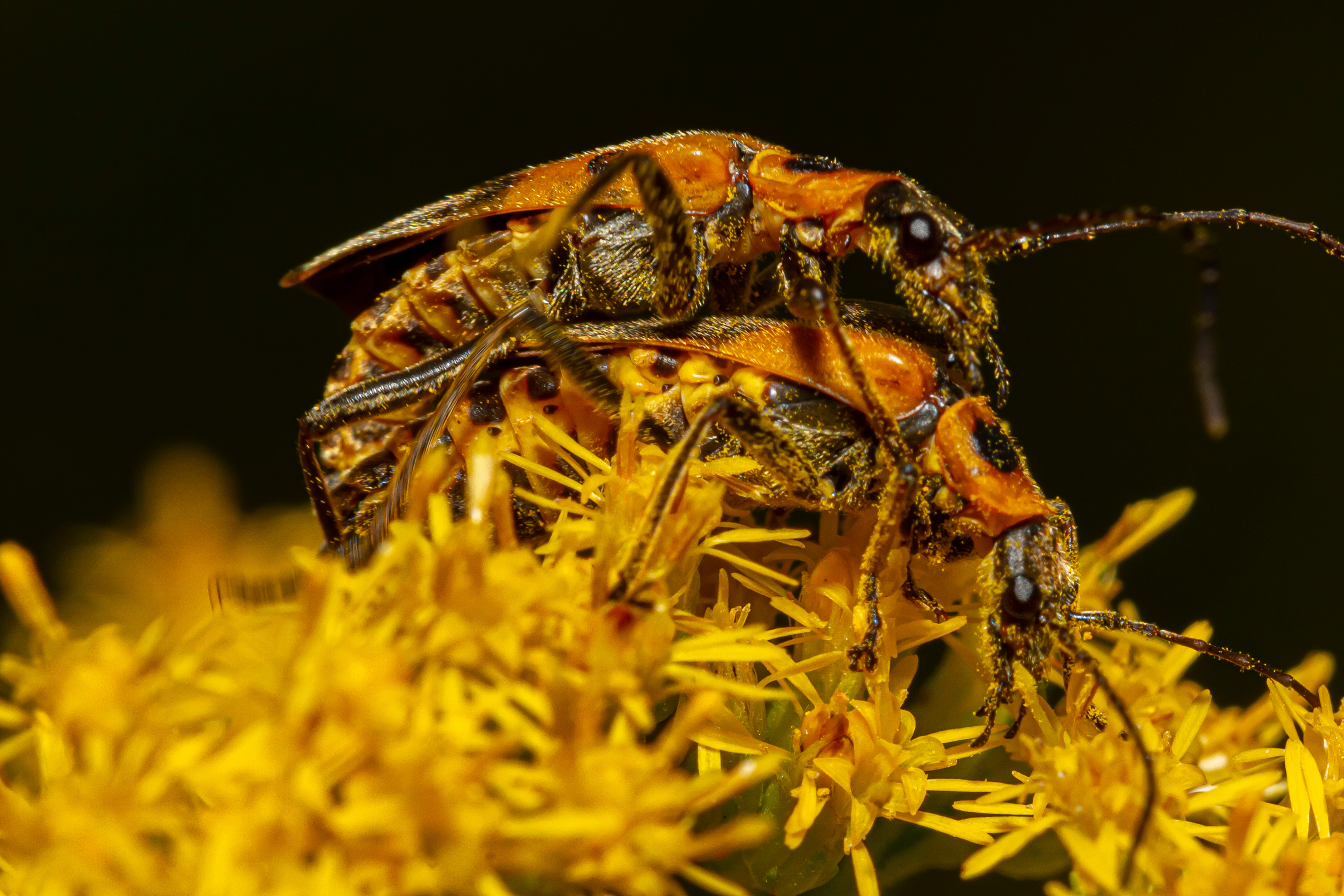
Goldenrod soldier beetles inadvertently transferring pollen while feeding on nectar and pollen grains. Photo by Grandbrothers, Adobe Stock.
Pollinators contribute to the reproduction of over 87 percent of the world’s flowering plants and are crucial for agriculture, with 75 percent of the different types of crops we grow for food relying on pollinators to some extent to achieve their yields. Perhaps most importantly, one-third of global food production is dependent on pollination.
While bees often take the spotlight in discussions about pollination, there’s a whole cast of lesser-known characters playing vital roles. From beetles, flies, ants, moths, and even birds and bats, a diverse array of creatures quietly ensures the fertility of our crops and the stability of our ecosystems.
Beetles as Pollinators
Beetles, often overlooked in the pollination process, play a crucial role as one of nature’s primary pollinators, especially for ancient flowering plants like magnolias and spicebush. These insects, which were among the first to visit flowers, are known as “mess and soil” pollinators due to their less-than-delicate approach. As they feast on petals and other floral parts, beetles inadvertently collect pollen on their bodies. They lack specialized structures for transporting pollen; instead, pollen grains adhere to their bodies as they move from flower to flower. The flowers that attract beetles tend to be large, bowl-shaped, and emit strong, fruity, or spicy scents to lure the beetles in. Despite their seemingly destructive behavior, beetles are essential for the reproduction of the plants they visit.
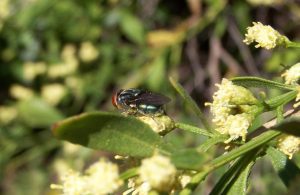
A fly lands on a saltbush, unintentionally aiding in pollination. Photo by Karan A. Rawlins, University of Georgia, Bugwood.org.
Flies as Pollinators
Flies, often dismissed as mere nuisances, are crucial pollinators. With their bustling activity around flowers, flies inadvertently transfer pollen from one flower to another as they search for nectar and other food sources.
Flies are particularly attracted to flowers with strong odors and dull colors, characteristics often overlooked by other pollinators. While they may not be as efficient or specialized as bees, flies make up for it in sheer numbers and ubiquity, contributing significantly to the pollination of a wide variety of plant species, including many crops essential for humans.
Moths as Pollinators
And then there are moths, the nocturnal counterparts of butterflies, silently pollinating flowers under the cover of darkness. Drawn to flowers with pale or white petals and strong fragrances, such as apple, pear, and cherry blossoms, moths play a role in pollinating various plant species, contributing to overall yield and quality of the harvest. Their long proboscis allows them to reach deep into flowers, accessing nectar sources that may be out of reach for other pollinators.
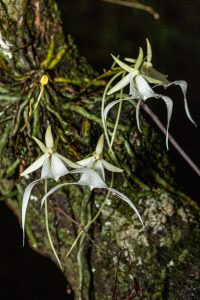
Ghost orchids (Dendrophylax lindenii) can provide shelter and nesting sites for arboreal ants, which in turn, may aid in pollination.
Ants as Pollinators
While ants are primarily known for their role as scavengers and defenders of their colonies, they also contribute supplementary to pollination of some plants in surprising ways.
In tropical forests, certain plants referred to as ant-plants or myrmecophytes, form close, sometimes obligatory partnerships with ants. These plants feature specialized hollow structures known as domatia, which serve as homes for ant colonies in exchange for protection and pollination services for the plant. Domatia vary by species, but can include stems, thorns, roots, stipules, petioles, or leaves. Some orchid species, such as the ghost orchid (Dendrophylax lindenii), which are native to Cuba and southwest Florida, provide shelter and nesting sites for an arboreal ant species called acrobat ants (Crematogaster ashmeadi). The ants, in turn, protect the orchids from herbivores and may aid in pollination.
Another strategy of some flowers is to develop nectaries on their exterior to entice ants, deterring other insects from stealing the nectar by accessing it from the side, thus compelling them to enter the flower in a manner more favorable for pollination. While ants can clearly contribute to pollination, researchers have also found that some ants secrete a natural antibiotic, which protects them from infections but harms pollen grains.
Birds as Pollinators
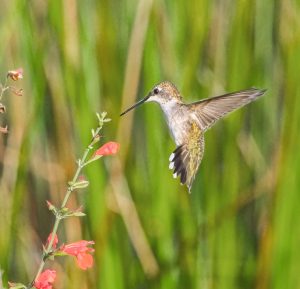
A juvenile male ruby-throated hummingbird serving as a pollinator as it flits from flower to flower, sipping nectar. Photo by Chase D’Animulls, Adobe Stock.
When we imagine pollinators, birds might not be the first creatures that come to mind. However, birds, comprising around 2,000 nectar-feeding species, play a significant role as pollinators among vertebrates.
Hummingbirds, with their tiny size and lightning-fast wings, are nature’s dynamos of pollination. Their slender bills and long tongues are perfectly adapted to extract the sugary nectar from flowers, inadvertently transferring pollen that adheres to their head and neck as they feed on other flowers. The ruby-throated hummingbird stands out as Florida’s prominent native bird engaged in plant pollination.
But it’s not just hummingbirds; other bird species, from sunbirds to honeyeaters, play their part in pollination too. Their behaviors, such as perching on flowers or probing deep into blossoms, can facilitate the transfer of pollen.
Bats as Pollinators
In the darkness of night, bats perform a vital ecological service: pollination. Particularly in tropical regions, bats have co-evolved with certain plant species, forming intricate mutualistic relationships. Surprisingly, over 500 plant species worldwide rely on bats for pollination, including important crops like agave, banana, cacao, guava, and mango.
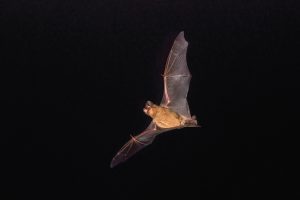
Even insect-eating bats, such as this Brazilian free-tailed bat, can inadvertently contribute to pollination as it feeds on insects within flowers. Photo by Phil, Adobe Stock.
In Florida, all native bats are insectivores, primarily preying on insects such as mosquitoes, moths, and beetles. However, recent research suggests that insect-eating bats may even outperform their nectar-feeding counterparts in certain cases when it comes to pollination efficiency. As these bats feed on insects inhabiting flowers, they inadvertently spread pollen during the process, highlighting the diverse and sometimes unexpected roles bats play in ecosystems.
Recognizing and conserving all pollinator species, from birds and beetles to bats and ants, is crucial for maintaining ecosystem balance and ensuring food security. By promoting pollinator-friendly practices and habitat conservation, we can safeguard the intricate web of life that sustains us all.

by Donna Arnold | Jun 5, 2024
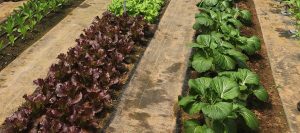
As you eagerly await the bountiful harvest from your spring and summer garden, remember that pests are also eyeing your crops. Scouting for pests is essential to maintain plant health and ensure a plentiful harvest.
The Importance of Scouting
Scouting involves the early detection of pests and plant diseases through regular and systematic garden inspections. This proactive approach helps identify pests early and assess the damage they might be causing. Missing just a few days of scouting can lead to significant plant damage due to the rapid life cycle of many plant-eating insects.
Understanding Your Garden Environment
To effectively scout for pests, familiarize yourself with the plants in your garden and their common pest issues. Different plants attract different pests, so knowing what to look for is crucial. Monitor your garden regularly, at least once a week, paying close attention to the undersides of leaves, stems, and flowers. Look for any leaf discoloration, such as yellowing or browning, and any unusual color changes. Note any insect activity, including the presence of eggs, holes in leaves, skeletonized foliage, insect frass (droppings), and entry holes.
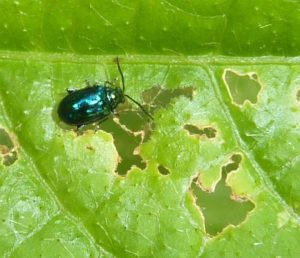
Photo: UF/IFAS
Tools Frequently Used in Scouting
Frequently inspecting your garden with the appropriate tools allows you to spot issues early and take steps to safeguard your plants. Common tools include:
- Traps: Used to catch and identify flying insects.
- Netting/Lures (Pheromones): Attract and capture specific pests.
- Sweep Net: Collect insects from plants.
- Containers: Collect samples to transport specimens for further examination.
- Hand Lens: For close inspection of small insects and eggs.
Common Garden Pests
Here are some common garden pests you might encounter while tending to your garden:
- Aphids: Small, soft-bodied insects that can be green, black, yellow, or brown. Often found on new growth, they cause curling and yellowing leaves and excrete sticky honeydew.
- Caterpillars (e.g., Tomato Hornworm): Large, green caterpillars with white stripes and a horn-like tail. They create holes in leaves, remove foliage, and damage fruits.
- Spider Mites: Tiny red or brown mites often found in clusters, creating fine webbing. They cause stippling on leaves, bronzing, and leaf drop.
- Whiteflies: Small, white, moth-like insects that fly up when plants are disturbed. They cause yellowing leaves, stunted growth, and secrete honeydew.
- Japanese Beetles: Metallic green bodies with bronze wings. They skeletonize leaves and damage flowers.
- Cutworms: Fat, brown, or gray larvae found curled under the soil surface. They cut off young seedlings at the base.
- Slugs and Snails: Soft-bodied, slimy creatures found in damp, shaded areas. They leave a trail of slime and create irregular holes in leaves and seedlings.
Scouting Techniques
Effective scouting techniques include:
- Visual Inspection: Check plants thoroughly, including the undersides of leaves and leaf axils.
- Sticky Traps: Place yellow sticky traps around the garden to catch flying insects like whiteflies and aphids.
- Shaking Plants: Gently shake plants over a white piece of paper to dislodge and spot tiny pests like spider mites.
- Soil Examination: Dig around the base of plants to look for soil-dwelling pests like cutworms.
Pest Management Strategies
Integrated Pest Management (IPM) relies on regular scouting for the most effective control. It combines several measures, including cultural, biological, mechanical, and chemical controls. gardeningsolutions.ifas.ufl.edu/…/integrated-pest-management.htm
Record Keeping
Maintain a garden journal noting the types of pests observed, population levels, and control measures taken. Track the success of different pest management strategies to refine your approach in future seasons.
By consistently monitoring your garden and employing a combination of these strategies, you can effectively manage pests and enjoy a healthy, thriving garden throughout the spring and summer seasons. For more information, contact your local extension office. Happy gardening!
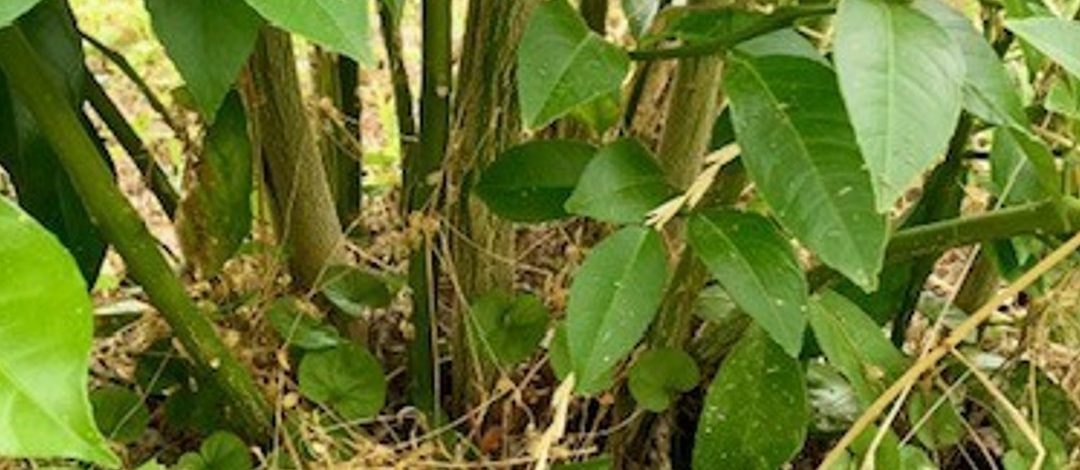
by Larry Williams | Jun 5, 2024
The widespread multiple night hard freeze that occurred in North Florida near the end of December 2022 resulted in numerous citrus trees becoming severely damaged. The above ground portion of many of these trees died as a result of the extreme cold.
I talked with numerous homeowners who were concerned about their citrus trees following that weather event. Many of these homeowners earnestly and hopefully watched for any sign of new growth on their cold injured citrus trees the following spring. When new growth appeared from the lower portion of the trunk and from the roots, the homeowner became excited with a false sense of hope that their citrus tree had survived and would again produce an abundance of desirable fruit.
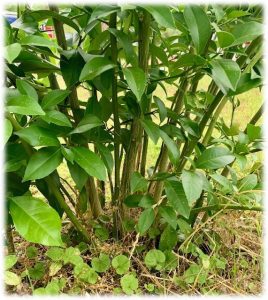
Cold injured citrus tree with new growth coming from rootstock. Credit: Larry Williams
Now in the spring of 2024, many of these citrus trees have somewhat regrown from those root shoots, not from the completely dead tops. In most cases, the freeze damaged, dead tops of the once large trees have now been pruned away to allow the multitude of small diameter vigorous green shoots to grow.
Most purchased citrus trees are grafted. So, what survived and is now regrowing is coming from the rootstock, not from the original, desirable, edible fruit producing top. That desirable top was completely killed.
To better understand this scenario, perhaps a basic definition of grafting will help. This definition was taken from a University of Missouri Extension publication on grafting. “Grafting is the act of joining two plants together. The upper part of the graft (the scion) becomes the top of the plant, the lower portion (the understock) becomes the root system or part of the trunk.” Understock is also known as rootstock.
Grafting involves joining two different individuals. These individuals have to be closely related. For example, citrus can be grafted to other types of citrus and peaches can be grafted to other types of peaches. But citrus cannot be grafted to peaches.
The rootstock was selected because of some beneficial trait(s): resistant to a root pest, superior cold hardiness, imparts a dwarf growth habit to the top, etc. But the same rootstock produces undesirable fruit: bitter, hard, extremely seedy, etc. The top (scion) was selected because of a superior fruit: sweeter, bigger, more disease resistant, etc. But the same scion produces an inferior/weak root system. So, grafting the two together allows for the “best of both worlds.”
When all that is left is originating at or below the graft union or rootstock, the eventual resulting fruit will usually be undesirable, sometimes not edible.
So unfortunately, the best option in this scenario is to start over with another healthy grafted tree that is well suited for the potential cold weather of extreme North Florida.

by Julie McConnell | May 30, 2024
The value of tomatoes produced in Florida in 2022 was $323,000,000 according to the USDA National Agricultural Statistics Survey and sometimes I feel like I’ll spend that much trying to get one perfect tomato in my garden. Nothing beats the taste of a fresh homegrown tomato, but unfortunately, they are susceptible to a wide host of diseases, insects, and even nematodes making them a challenge for even the most seasoned gardener.
Some of these pests can be tolerated without too much reduced yield, while others warrant removal of the plant to prevent further spread. Over the past couple of weeks, we have received a lot of calls about tomato plants that look normal and full of fruit one day then wilt despite plenty of available water. This symptom can be caused by a litany of ailments but when you also notice stem discoloration and perform the bacterial ooze test it is a pretty strong indicator that the cause may be bacterial wilt*.
The bacterial ooze test is simply taking a freshly cut stem of a symptomatic plant and placing it cut-side down into a glass of water (can be plastic but must be transparent) and watching for bacterial streaming. This will look like ribbons of goo coming out of the stem – that is not a technical term, but when you see it, you know it.
Bacterial wilt caused by Ralstonia solanacearum (Previously Pseudomonas solanacearum) affects over 200 species of plants. There are many strains including those affecting tomato, potato, and eggplant – all members of the nightshade family and commonly grown plants. If infected plant material is in the garden, it can spread to susceptible plants through wounds in roots or stems, nematode feeding, contaminated irrigation water, infected weeds, pruning equipment, and surface runoff. The pathogen can also remain viable in the soil for years, requiring well-planned crop rotation practices.
There is no cure and the best a gardener can do is spot it early and use good sanitation practices and crop rotation to minimize spread. For more information on this disease visit https://plantpath.ifas.ufl.edu/rsol/Trainingmodules/RalstoniaR3b2_Sptms_Module.html
Visit U-scout Tomato Diseases to view common tomato disease symptoms https://plantpath.ifas.ufl.edu/u-scout/tomato/index.html
*Please note that symptom observation and bacterial streaming tests do not constitute a definitive diagnosis and lab analysis is recommended for commercial producers.

Streams of bacterial ooze began about 5 minutes after placing tomato stem in water. Photo: J. McConnell, UFIFAS
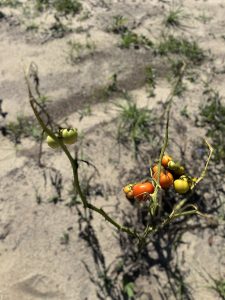
Symptoms of tomato bacterial wilt worsen during fruit ripening. Photo: J. McConnell, UFIFAS

















